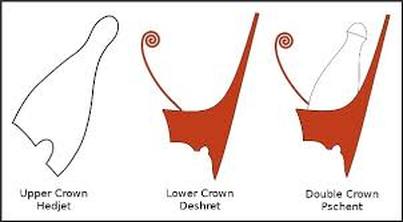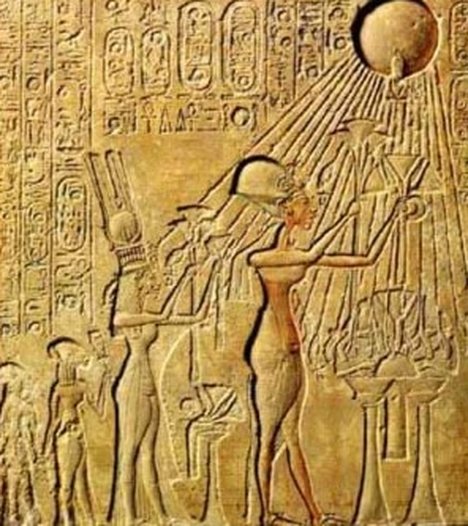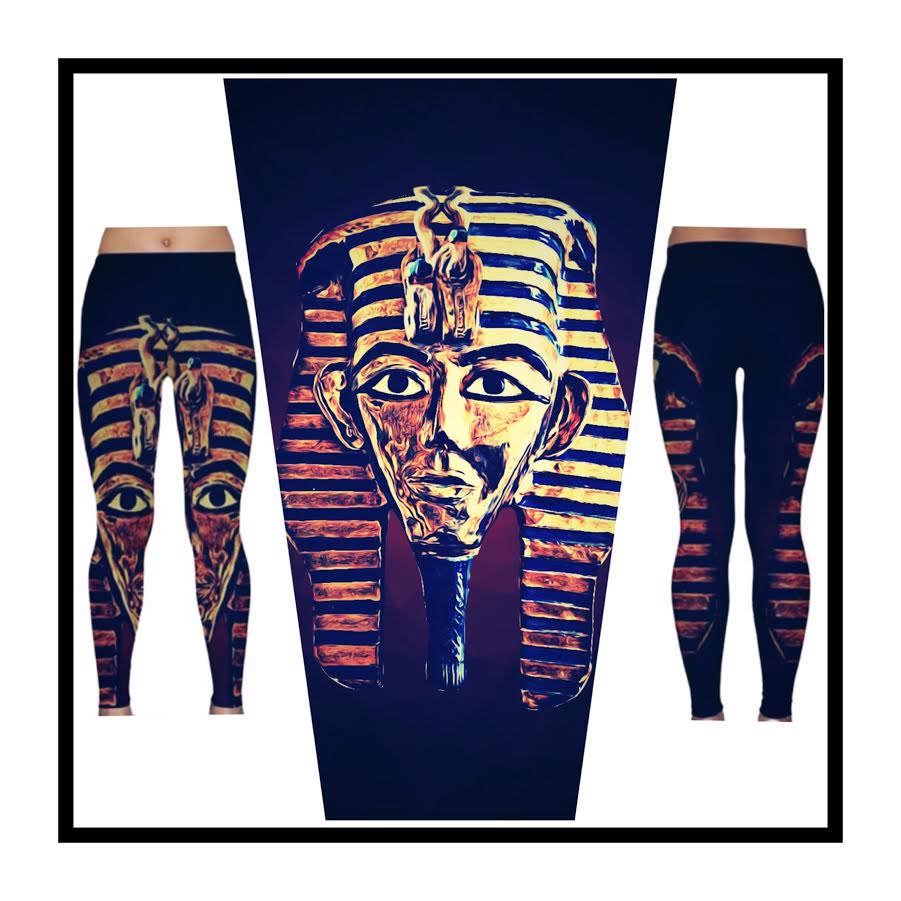India is commonly known as the motherland of yoga, but what if I told you that yoga originally began in Egypt and then traveled to India hundreds of years later?
Paintings, engravings, and murals from ancient Egyptian tombs and temples show images of figures in positions that represent some commonly known yoga poses.
According to the book, Egyptian Yoga: Postures of the Gods and Goddesses by Dr. Muata Ashby and Dr. Karen Ashby….
According to the book, Egyptian Yoga: Postures of the Gods and Goddesses by Dr. Muata Ashby and Dr. Karen Ashby….
We can find the god Geb (god of the Earth) in plough pose engraved on the ceiling of the Temple of Aset (Isis).
Framing him is the goddess, Nut (goddess of the sky), in a forward fold yoga pose.
Further, we can see Geb in a spinal twist and Ra in the squatting position like Virasana, Hero’s pose.
Dr. Ashby proclaims that yoga was practiced in Egypt earlier than anywhere else in our history, long before the evidence is detected in India (including the Indus Valley Civilization) or any other early civilization (Sumer, Greece, China, etc.). This point of view is supported by illustrative and documented scriptural evidence of physical exercises, meditations, and implementation of wisdom teachings in daily life.
It is commonly believed that the practice of the yoga in India began with the use of the Lotus Pose, which is traced to stone engravings in the Indus Valley culture (1500 BCE). However, the use of the lotus pose here could possibly only symbolize the iconography of meditation. This seated flower position represents a spiritual person who develops detachment and dispassion from the world since it sits in the muddy water but is not touched or affected by the mud. Yoga poses, as we know them in the western world, developed much later in India’s history.
Lotus Pose from the Indus Valley
Ancient Civilizations
Ancient Civilizations
Through ancient Egyptian mythology, we can see the attempt of humankind to understand divine energy. Their gods and goddesses are symbols of cosmic forces in nature and in the mind. The ancient Egyptians believed that by acting and moving like these divine beings, they could develop their own dormant divine qualities, producing spiritual enlightenment. As these ancients practiced the postures, they saw themselves embodying the ideologies of the ruling deity of that posture. In other words, if they needed fertile land to grow crops, they would practice plough pose for Geb, god of the earth.
Sema is an Ancient Egyptian word and symbol meaning union. The hieroglyph symbol of Sema represented the union of two lungs at the trachea, symbolizing the union of the Higher and lower self. Recognizing balance of duality, like observing Yin and Yang, night and day, inhale and exhale, leads to the knowledge of the divine consciousness.
The ancient Egyptian god, Asar, symbolized the Higher Self, the essence of all things and the very soul of every human being.
Over time, Divine has become limited in association with the human body due the lower self. The lower self feeds the desires of the mind where it experiences pain and pleasure in the world of time and space. In this way, it is the Ancient Egyptian god Set, as the force of our impulses and desires, that separates us from our higher intellect.
Instead of oneness and unity, we often see separateness which promotes egoistic (selfish) and violent behavior like greed, hatred, anger, lust and other human failings. In contemporary philosophy, we call this the ego. Learn more in my blog about our dark side.
Similar to the duality concept of our higher and lower selves, in ancient Egypt, there were two Kingdoms called Lower Egypt and Upper Egypt. Both of these kingdoms had their own religions. During the Early Dynastic period (c. 3100 to c.2680 B.C.), the two kingdoms, of Upper and Lower Egypt, were united under King Narmer, so he and his successors are referred to as the First Dynasty (family rule). From that time on the pharaohs are shown in paintings wearing a double crown, white for Lower Egypt and red for Upper Egypt.
Sema is an Ancient Egyptian word and symbol meaning union. The hieroglyph symbol of Sema represented the union of two lungs at the trachea, symbolizing the union of the Higher and lower self. Recognizing balance of duality, like observing Yin and Yang, night and day, inhale and exhale, leads to the knowledge of the divine consciousness.
The ancient Egyptian god, Asar, symbolized the Higher Self, the essence of all things and the very soul of every human being.
Over time, Divine has become limited in association with the human body due the lower self. The lower self feeds the desires of the mind where it experiences pain and pleasure in the world of time and space. In this way, it is the Ancient Egyptian god Set, as the force of our impulses and desires, that separates us from our higher intellect.
Instead of oneness and unity, we often see separateness which promotes egoistic (selfish) and violent behavior like greed, hatred, anger, lust and other human failings. In contemporary philosophy, we call this the ego. Learn more in my blog about our dark side.
Similar to the duality concept of our higher and lower selves, in ancient Egypt, there were two Kingdoms called Lower Egypt and Upper Egypt. Both of these kingdoms had their own religions. During the Early Dynastic period (c. 3100 to c.2680 B.C.), the two kingdoms, of Upper and Lower Egypt, were united under King Narmer, so he and his successors are referred to as the First Dynasty (family rule). From that time on the pharaohs are shown in paintings wearing a double crown, white for Lower Egypt and red for Upper Egypt.
When the two kingdoms became one, many of the religious beliefs and cultures were combined, and so there are many different names to represent some of the combined gods and goddess over the course of 3,000 years.
The gods and goddesses were often set up in sets of two, each showing the opposite site, such as life and death. Other gods were associated together because they were similar, such as Amun, the god of hidden power who was paired with Ra, the god of the sun. While the ancient Egyptians didn’t worship the animals themselves, they would sometimes show their various gods and goddesses with the heads of certain animals of power. A specific god could also have more than one animal to represent him, especially after the upper and lower united.
For hundreds of years, the dynastic rulers, pharaohs, spent their living life with focus on the afterlife. The ancient Egyptian ‘Book of the Dead’ is part of the Egyptian religion. It contains all the information that is needed for the spirit of someone who has died to get through the trials and tests and emerge to their afterlife. Hieroglyphs and passages have been found on the walls of many burial tombs. They include illustrations and pictures that sometimes show the individual person as they make their journey to their afterlife.
The Museum of Man, in San Diego, has one of the most important ancient Egyptian collections in the United States.
This collection features painted coffins, masks, mummies, figurines, hieroglyphic stone carvings, jewelry, pottery, amulets, everyday objects, and a mummified falcon. All of these objects were found in tombs.
Small funerary figurines call ushabtis covered the floor around a sarcophagus. These were called answerers because they carried inscriptions about their readiness to answer to the god’s command to work, after the pharaoh passed away. Produced in huge numbers, ushabtis, along with scarabs, are the most numerous of all ancient Egyptian antiquities to survive.
The gods and goddesses were often set up in sets of two, each showing the opposite site, such as life and death. Other gods were associated together because they were similar, such as Amun, the god of hidden power who was paired with Ra, the god of the sun. While the ancient Egyptians didn’t worship the animals themselves, they would sometimes show their various gods and goddesses with the heads of certain animals of power. A specific god could also have more than one animal to represent him, especially after the upper and lower united.
For hundreds of years, the dynastic rulers, pharaohs, spent their living life with focus on the afterlife. The ancient Egyptian ‘Book of the Dead’ is part of the Egyptian religion. It contains all the information that is needed for the spirit of someone who has died to get through the trials and tests and emerge to their afterlife. Hieroglyphs and passages have been found on the walls of many burial tombs. They include illustrations and pictures that sometimes show the individual person as they make their journey to their afterlife.
The Museum of Man, in San Diego, has one of the most important ancient Egyptian collections in the United States.
This collection features painted coffins, masks, mummies, figurines, hieroglyphic stone carvings, jewelry, pottery, amulets, everyday objects, and a mummified falcon. All of these objects were found in tombs.
Small funerary figurines call ushabtis covered the floor around a sarcophagus. These were called answerers because they carried inscriptions about their readiness to answer to the god’s command to work, after the pharaoh passed away. Produced in huge numbers, ushabtis, along with scarabs, are the most numerous of all ancient Egyptian antiquities to survive.
Ushabtis at The Museum of Man, San Diego
These artifacts are from the ancient city of Amarna, where the Pharaoh Akhenaten and Queen Nefertiti reigned, and the famous young King Tut spent his boyhood.
Following all this confusion of multiple gods and changing names and animal figures of gods, a unique king unified the concept of divine. Akhenaten is my favorite Pharaoh because he established worship of the light and the higher self of love.
Akhenaten rose to power during the 18th Dynasty, around 1300 BCE and he is especially noted for abandoning traditional Egyptian polytheism and introducing worship centered on the Aten, the sun. This light was envisioned as a sun disk whose rays ended in hands touching and caressing those on earth. His original name was Amenhotep IV, but after the first year of his reign, he changed it to mean “effective for Aten.”
Following all this confusion of multiple gods and changing names and animal figures of gods, a unique king unified the concept of divine. Akhenaten is my favorite Pharaoh because he established worship of the light and the higher self of love.
Akhenaten rose to power during the 18th Dynasty, around 1300 BCE and he is especially noted for abandoning traditional Egyptian polytheism and introducing worship centered on the Aten, the sun. This light was envisioned as a sun disk whose rays ended in hands touching and caressing those on earth. His original name was Amenhotep IV, but after the first year of his reign, he changed it to mean “effective for Aten.”
This time period was known as the Amarna Period because Akhenaten moved the capital of Egypt from Thebes to a place called Amarna. The city was built in the middle of Egypt facing towards the east and precisely positioned to direct the rays of the morning sun toward temples and doorways. Each day, Akhenaten and Nefertiti processed, in their chariots, from one end of the city to the other, mirroring the journey of the sun across the sky (Ancient.eu).
It is theorized that Akhenaten was the first recorded ruler, in the world, to envision a single, supreme deity who cared for the individual lives of human beings. His image of Aten was an all-loving, all powerful, supreme creator and sustainer of the universe. By worshiping Aten, Akhenaten displaced the idea that the pharaoh was a god.
Sigmund Freud suggests that this pharaoh’s reign, of 17 years, altered the course of world civilization. In his 1939 work Moses and Monotheism, Freud argues that the biblical Moses was an Egyptian who had been a devotee of the Cult of Aten, throughout his upbringing, and was driven from Egypt following Akhenaten’s death.
Sigmund Freud suggests that this pharaoh’s reign, of 17 years, altered the course of world civilization. In his 1939 work Moses and Monotheism, Freud argues that the biblical Moses was an Egyptian who had been a devotee of the Cult of Aten, throughout his upbringing, and was driven from Egypt following Akhenaten’s death.
| Learn More at Goodreads |
In this new religion, Akhenaten focused on what can be seen now, with an emphasis on the light of the sun. Before Akhenaten's time, the pharaoh, from the images from other dynasties of Egyptian history, was routinely depicted in an angular, linear form with wide, broad shoulders, a strong body, and an emotionless, ageless face.
Akhenaten, Nefertiti, and their children blessed by the Aten (Solar Disk),
18th century. Relief from Akhetaten (Tell el-Amarna).
18th century. Relief from Akhetaten (Tell el-Amarna).
Love between Akhenaten and Nefertiti
Art from the Amarna Period depicts the royal family with a new sense of realism including naturalistic physical features and familial affection. Akhenaten was portrayed with a more curvilinear approach, organic lines over solid, straight ones. This added an androgynous look of masculine and feminine coming together and finding unity. His torso became slim with wide hips, and his neck, face, and fingers were elongated as well. His imperfections were highlighted rather than hidden in ideal proportions, as noted in his pudgy belly. (Ancient Origins)
Akhenaten is depicted with his wife Nefertiti, in brief moments of life, rather than the eternal nature of his reign. He is portrayed as a good and kind father, dynamic in day to day activities and enthusiastically playing with his children.
Akhenaten is depicted with his wife Nefertiti, in brief moments of life, rather than the eternal nature of his reign. He is portrayed as a good and kind father, dynamic in day to day activities and enthusiastically playing with his children.
Akhenaten’s son, Tutankhamun or “King Tut” is probably the most well-known Egyptian pharaoh today because his burial tomb is one of the few that was discovered with everything still in it! Tutankhamun (reigned 1336-1327 BCE) was only ten years old when he became a pharaoh, and he was known as the ‘boy king’. He was given the name Tutankhaten at birth but changed his name upon ascending the throne to reflect his rejection of Atenism and his return of the country to the ways of Amun and the old gods.
Many years ago, I was inspired by the impressive pattern and form of King Tut’s burial mask, so I somewhat replicated it in ceramics, with gold paint, as a study in portraiture.
Many years ago, I was inspired by the impressive pattern and form of King Tut’s burial mask, so I somewhat replicated it in ceramics, with gold paint, as a study in portraiture.
Ancient Egyptian by Hannah Faulkner
Now, this design is available on my yoga leggings!
The San Diego Museum of Man in accordance with Yoga One San Diego come together twice a month (2nd and 4th Saturdays) at 8:30am-9:30am to hold a special yoga class in the Rotunda.
I have the honor to teach the class this February 11th, 2017.
Will you join us for this journey in Ancient Egypt?
I have the honor to teach the class this February 11th, 2017.
Will you join us for this journey in Ancient Egypt?
Egyptian mythology, when understood as a system of Yoga, gives every individual insight into our own divine nature. The ultimate goal of yoga is to awaken the spiritual consciousness, the divine energy that connects us all.
The practice of yoga poses can be a journey of self-discovery and not simply as a chore simply to keep the physical body fit. The promotion of health is only a byproduct of the practice, and not an end in itself. However, these postures also simultaneously affect the nervous system and mind. To receive the full benefits of oneness and spiritual awakening, a yogi should also integrate meditation, reflection, and conscious living.
Through a unified approach of poses and lifestyle, we can awaken our loving energy of light and unity that is resting within each of us. See yourself as the creator of your own life, the sustainer of your reality. Breathe in the light of oneness and divine energy and see yourself connecting with life itself.
The practice of yoga poses can be a journey of self-discovery and not simply as a chore simply to keep the physical body fit. The promotion of health is only a byproduct of the practice, and not an end in itself. However, these postures also simultaneously affect the nervous system and mind. To receive the full benefits of oneness and spiritual awakening, a yogi should also integrate meditation, reflection, and conscious living.
Through a unified approach of poses and lifestyle, we can awaken our loving energy of light and unity that is resting within each of us. See yourself as the creator of your own life, the sustainer of your reality. Breathe in the light of oneness and divine energy and see yourself connecting with life itself.






















